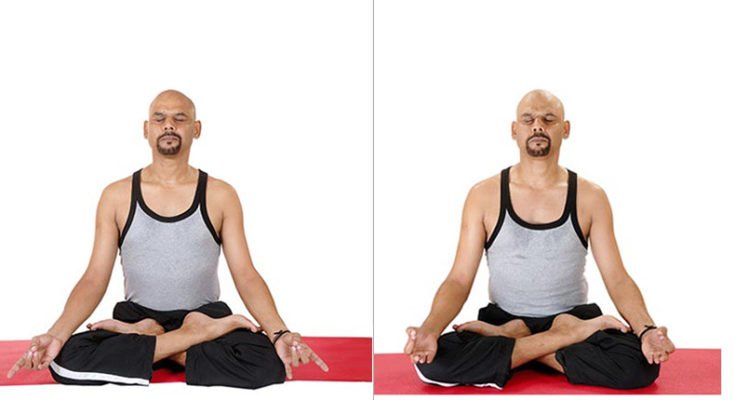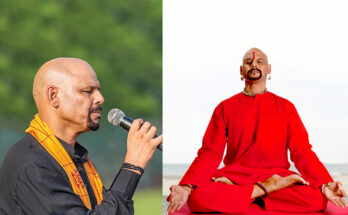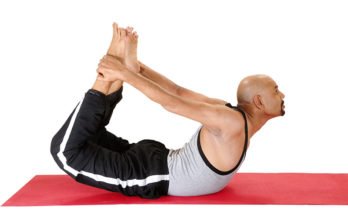Agnisar Kriya (left) and Kapalbhati Pranayama (right) – the process of winter yoga demonstrated by Yogaguru Suneel Singh. image Courtesy – Vijay Gautam.
Winter is upon us but does that give you the excuse to stay at home for next two months certainly not. Especially if you want to stay in good health and maintain yours shape. Nothing can be compared to the feeling of snuggling in a blanket on a chilly winter morning.
Cold, dark mornings and winter nights are not particularly favourable to encourage you rolling out your mat and start your regular yoga class. However, it is perhaps the single most important decision that you could make your mind and body ready as you move through the coldest season of the year. Quick yoga and lifestyle tips to help you cope with some common problems which the season brings along and to make you better enjoy winter. Yoga postures, such as forward bends and inversions, practiced in a supported and relaxed way aim to relax the nervous system through the parasympathetic nervous system (rest, relax, digest) and boost the body’s innate ability to heal itself through the immune response.
In general, practicing asana (postures) maintains joint mobility and increases circulation while loosening stiffness within the joints. Cold weather may not necessarily be the only contributing factor to joint pain in winter. The barometric pressure changes during colder weather can also increase joint pain. In winter for beginner or an intermediate practitioner they should practices dynamics yoga, mean instead of holding a pose for few seconds, one should practice each Shuksham vayama and Asana 2 to 5 times continuously. While practicing yoga in winter it advisable to practice indoor yoga, proper warm up and subtle kriyas. To have good heath, lots of energy and a calm mind we should honor our body by working within rhythm of nature. So, winter yoga is essential for everybody.
1. Drink plenty of water: if you suffer respiratory illness be sure to drink 10 to 12 glass of water or other fluids daily.
2.Blow up a balloon: Getting relief from a persistent breathing problem, try blowing up balloons; because blowing of balloons help to increase capacity of the lungs.
3. Sore Throat: Take 1000 to 3000 mg of vitamin C daily to help fight the cold or other viral inhalation causing it.
Read: Yogic ways to control Obesity
4. LINGAM MUDRAS: close your hands so that the fingers are interlock. Keep left thumb up straight. Then touch index finger and thumb of right hand, so they are circling the left thumb. Do this mudra for 2 to 3minutes.This mudra very good for respiratory ailments, Asthma, coughs, cold and congestion.
5. SINGHASANA: Sit in Vajrasana with the knees about up 45 cm apart. Place the palms of hands on the floor between the knees, with finger posting forward and open the eyes gaze at eye brow center. Inhale slowly through nose at the end of inhalation open the mouth and extend the tongue out as far as possible. And then slowly exhale produces clear and study loin roaring sound from your throat. Keep the month wide open. Then close the mouth this is one round do 5 rounds daily.
Benefits: This is an excellent asanas for alleviating disease of the throat, nose ears eyes and mouth.
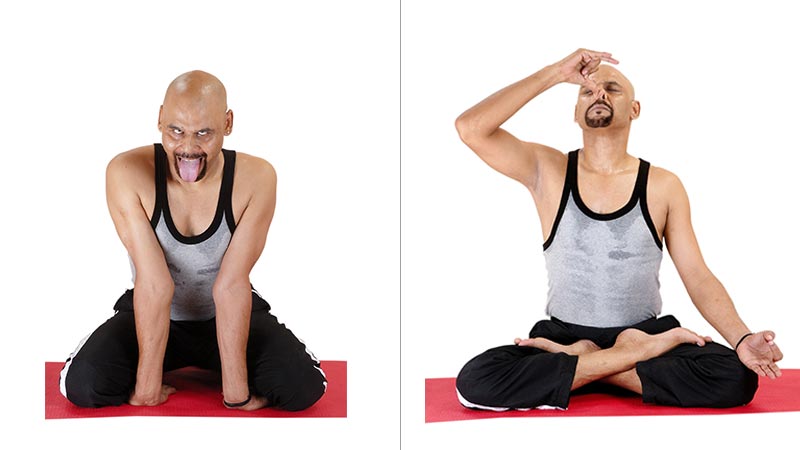
Singhasana (left) and Suryabhedi Pranayama (right)
6. SURYA BHEDI PRANAYAMA: sit in comfortable mediation pose head and spine straights eyes closed hand in Gyan Mudra, now close the nostril with ring finger and inhale slowly and deeply through the right nostril. Then close both the nostril after few seconds, exhale slowly through left nostril by keeping the right nostril closed with the right finger. This is one round. Do it minimum 20 times in a day.
Benefits: This pranayama creates heat in the body and counteracts imbalances of the wind elements. It makes mind more alert and good for low blood pressure.
Precaution: people suffering from heart disease, H.B.P and epilepsy should not practice this pranayama.
7. VAJRASANA: Sit on the floor in kneeling position. Bring the big toes together and heels spread out. Rest comfortably on seat made out by the feet. Keep your hands on the knees and palms facing down? Keep the eyes closed and head, neck and back in vertical alignment. Do at least minimum for two to five minutes.
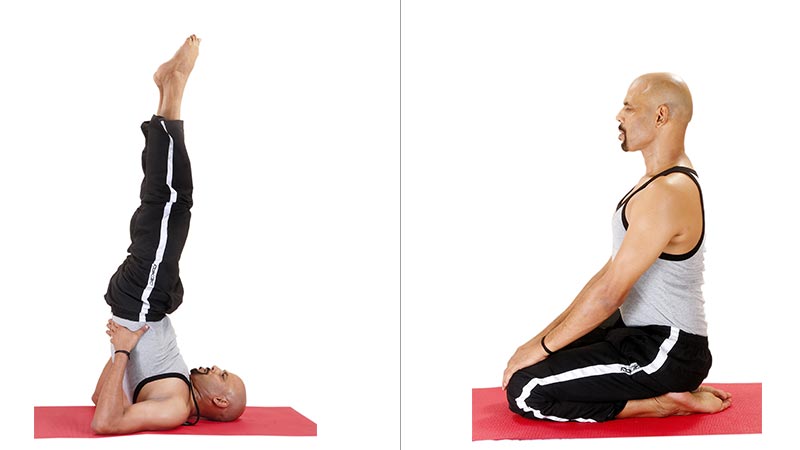
Sarvangasana (left) and Vajrasana (right)
BENEFITS: This is the only asana in yoga which we can do after meals. By doing this asana gastric problem do not occur, it is very good for high Blood Pressure, tension, heart diseases, pain in the knees, legs and calves gets cured.
8. AGNISAR KRIYA: Sit in comfortable position keep your hands on the knees. Exhale deeply and fully emptying out your lungs completely and pull the abdomen towards the spine. Hold breath pull your abdomen forward and backward as many times as possible. In the beginning do it four to five times. But after practice you will be able to do ten to fifteen times easily. Do it at least five rounds of this kriya.
BENEFITS: This kriya improves digestion by increasing the fire element in body. It also reduces of obesity and improves blood circulation.
Read: Several ways of doing meditation
9. SARVANGASANA Method: Lie down on the back and relax completely. Slowly raise the legs, hips and trunk in a continuous movement until vertical. Raise the legs – keeping the knees straight and hips by supporting the arms on the ground then bend the elbows and hold the trunk in the hand. In this posture the chin in buried in the upper chest. Retain the position as long as it is comfortable. Then come down slowly. Relax do it only once.
BENEFITS: Blood supply to the organs in the upper part of the body such as eyes, heart, face, thyroid, roots of spinal nerves and brain. As a result circulatory congestion is relived and hormones flow into blood freely. This asana used in yoga therapy for the treatment of Asthma, Diabetes, Colitis, Thyroid disorders, Impotence and Menopause.
CAUTION: Those suffering from High B.P, Heart Ailments, Cervical pain and slipped disc should refrain from doing this asana.
10. SHAVASANA: Lie flat on the back with arms about 15cm away from the body. Palms facing up-wards. Let the fingers of your both hands curl up slightly. Close the eyes. Your head and spine should be on a straight line. Ease your whole body and stop all physical movements. Feel your natural breathing. Now, with every inhalation chant the word SO and with every exhalation think of the word HUM repeat the mantra for five to 10 minutes. Duration according to time available. Physical first on relaxing the whole body then on the breath. And spiritually on AJNA CHAKRA (Eye brow center gazing is called ajna chakra).
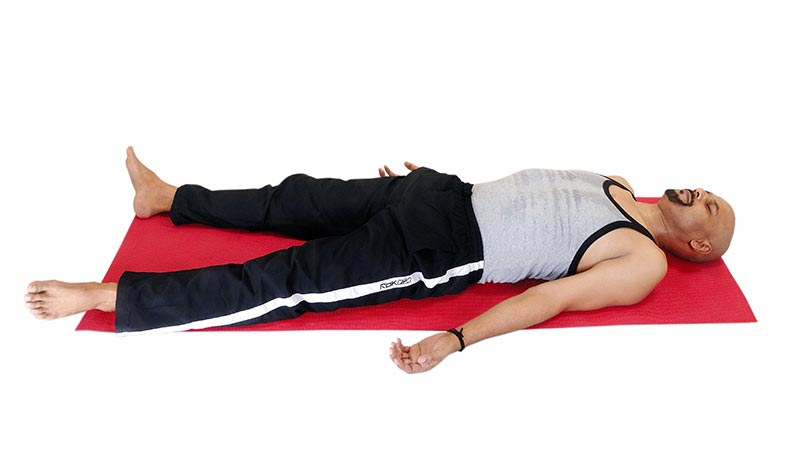
Shavasana demonstrated by Yoga Guru Suneel Singh
BENEFITS: This asana relax the whole psycho –physiological system. It should be practiced before sleep also tries not to move body at all during practice of this asana, because slightest movement will create muscular contraction. This asana works as Ram Barn for. H. B. patients, Heart patients, depression and stress.
11. KAPALBHATI PRANAYAMA: Kapal means forehead and Bhati means light or knowledge. Hence Kapalbhati pranayama bring a state of light or clarity to the frontal region of the brain. Sit in any comfortable position. Keep head and spine straight and hands resting on the knees in Jhyana Mudra. Close the eyes and relax the whole body. Now without paying attention to inhaling, exhale with force rapidly and vigorously. Inhalation should be spontaneous involving no effort with each exhalation pull in the abdomen toward the spine. Perform 10 respirations to begin with. Continue the practice and slowly increase respiration.
BENEFITS: This pranayama is useful for detoxifying the body. It improves the memory and sharpens the mind. Diseases like asthma, respiratory troubles, allergies and sinus etc get cured. This pranayama purifies Ida and Pingla Nadis and also removes sensory distraction from the mind. It also relieves constipation, gas; blockages in arteries are also cleared. It also helps in losing weight. Generates heat in the body. Peace and stability of mind is secured.
CAUTION: Those having high blood pressure, heart disease, epilepsy, hernia, should not practice kapalbhati pranayama.

